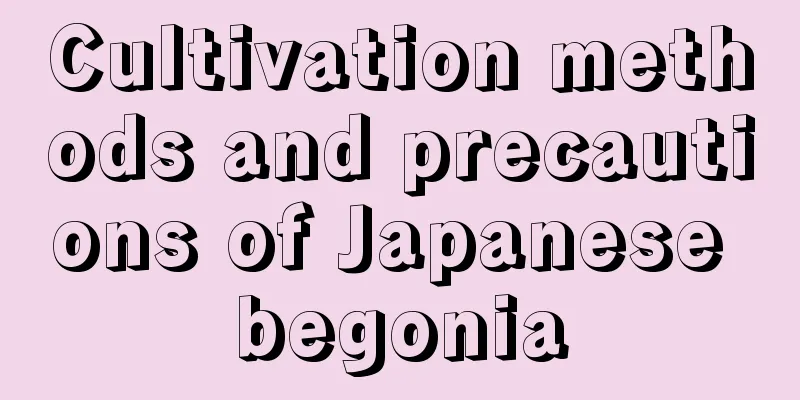Cultivation methods and precautions of Japanese begonia

1. Breeding methods(1) Soil: Acidic or neutral soil is best for cultivation. Its composition can be a mixture of river sand, leaf mold and sawdust. Nutrient soil made of leaf mold, field soil and sand in a ratio of 5:3:2 is also acceptable. Be careful not to use saline-alkali soil and clay soil, otherwise it will lead to poor growth. (2) Temperature: Its optimal growth temperature is between 18 and 20 degrees Celsius. Since it is relatively cold-resistant, it can be placed outdoors as long as the room temperature is not lower than 10 degrees Celsius. (3) Sunlight: It is a plant that prefers sunlight and is suitable to be placed in a sunny place with good light and ventilation. If it is placed in a cool, dark place for a long time, its growth will be hindered, so make sure it has enough light time. (4) Watering: Water as little as possible during the germination period. Increase the amount of watering during the growth period, and water twice a day. Be careful when watering, do not pour water on the stems and leaves, and water slowly along the edge of the pot, otherwise water will accumulate in the stems and leaves, which will easily cause rot. (5) Fertilization: Normally, it does not require fertilizer, but in autumn, when the begonia leaves fall, a large amount of nutrients will be lost, so a large amount of fertilizer should be applied to replenish nutrients. In early spring, you need to apply fertilizer once and water thoroughly once, which will allow the fertilizer to fully penetrate the soil. 2. NotesAfter its leaves fall and before it sprouts in spring, it needs to be carefully pruned to remove dead branches, diseased branches and weak branches to increase its light transmittance and ventilation. If you want to increase the number of flower buds, you need to shorten the long branches so that other axillary buds can obtain more nutrients. You also need to pinch them in time to prevent the nutrients from being dispersed. |
<<: Cultivation methods and precautions of money tree
>>: How to propagate green radish
Recommend
Kiwifruit Management Measures in February
The arrival of February means the beginning of sp...
What is Malantou?
What is Malantou? Amaranthus is a plant of the As...
To the fruit pots she planted, I wanted to throw all my flowers away!
1. Watermelon potted plants 1. Clean the watermel...
How to keep petunias in winter at home
Position First of all, petunias should be placed ...
How to make a jasmine potted plant
1. Prepare materials 1. Artificially cultivated o...
How to switch from soil-grown Clivia to hydroponics
1. Steps The first thing we need to do is wash th...
Why can Forsythia bloom out of season?
Off-season flowering of Forsythia Under normal ci...
Planting time and cultivation technology of ice plant
Ice plant, scientifically known as ice leaf sunfl...
When is the best time to sow coriander seeds?
Coriander seed sowing time Coriander is usually p...
How to prune the iron begonia and what are the pruning times and methods
Pruning time of Begonia thornii The iron hollyhoc...
The top 10 most profitable crops in the future
1. Houttuynia cordata Houttuynia cordata is a Chi...
How to care for the fragrant vine in winter
Is the fragrant vine afraid of freezing? The frag...
How to propagate chrysanthemum
Cutting propagation time of lover's chrysanth...
Why do people say that green radish attracts ghosts? Is it true that green radish has evil spirits?
1. There is no saying that ghosts are summoned Th...
How to fix wilting flowers
You must feel heartbroken watching your beloved f...









